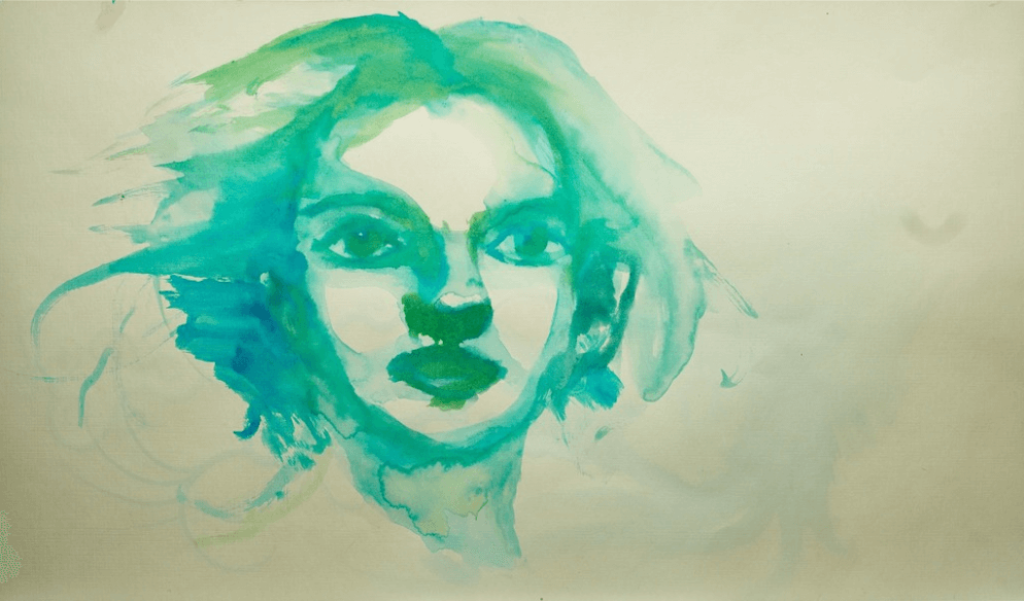From Bouvier to Blockchain: A Convo with Alexandra Bregman

“Woman’s Face in Green,” watercolor on paper, 2017.
While working in advertising, Alexandra Bregman was surprised when her art found its way to Sotheby’s at this February’s MvVO Art showcase. We took the opportunity to catch up with our Editor-at-Large, an in-house emerging artist.
Anna Mikaela Ekstrand: Your work was recently on view at Sotheby’s as part of MvVO ART. The exhibition presented works by artists working in the field of advertising. Congratulations! When did you begin thinking about yourself as an artist, and how did you make it to that point?
That’s a surprisingly complicated question. The short answer is 2017 when I was considering (and eventually selected for) the MvVO showcase. But I was working as a caricaturist when I was 15…and some of my earliest memories involve crayons and markers. So in many ways, I have seen myself as an artist from toddlerhood.
I was an art history major and also attended college in Paris for a period of time, as did you! It really is the best city for seeing art.
Paris was an amazing experience. At 19, I was able to take art history and drawing classes, then walk to the Louvre and see a myriad of masterpieces firsthand. Making that connection on such a sophisticated level was a huge intellectual breakthrough for me and helped to crystallize my interest in the arts.
My class at La Grande Chaumière in Montparnasse was certainly enriching, although it did not turn me into Picasso or Manet…at least, not yet.
Given your experience as an Asian art writer, does Asian art influence your work?
Yes — I am especially inspired by the meditative ideology at Ippodo Gallery, and Japanese values of respect for the natural world and moments of controlled stillness. I also am passionate about the colorful elements of the Progressive Artists Group paintings from India, whose unique approach to Abstract Expressionism came to define a post-colonial aesthetic direction.
When I was first introduced to your paintings, I thought many of the works were self-portraits.
I think all work is at some level autobiographical. There has to be a reason someone decides to pursue and/or create. If you see a bit of me in a painting, that’s probably just because I made it.
Does your artistic practice as a painter ever have any overlap with your work as a writer?
The intersection between journalism and painting concerns observation. How does a person perceive the facts, and how does that same person channel independent bias? I think journalism is a processing of information and painting of emotion.
While studying at Columbia Graduate School of Journalism, you wrote a very strong investigative piece detailing the Russian oligarch Dmitry Rybolovlev’s multi-million dollar holdings of artworks by Amedeo Modigliani. What is your attitude towards these types of high-level art investments?
Art as investment is about financial strategy and trophy hunting. It runs concurrently to the emotive and evocative realities of artists and their creative processes. At worst, dare I say independently?
I will always be obsessed with the polished adventures of the blue-chip art world, and all the salaciousness that goes along with the millions. It’s just fascinating.
We both bought our first Ethereum at the same time last summer. Actually, you bought yours earlier. What do you think about cryptocurrency?
The level of speculation in the crypto market is completely over-the-top. Because the initial volatility resulted in such sudden wealth, the space was flooded with self-proclaimed experts and amateur millionaires. I tried to get the C-suite at the advertising agency to be passionate about it, but they just couldn’t get behind something that seemed so subjective. Nevertheless, I have weeded through a lot of opinions and realized some pretty simple patterns.
It seems like a throwaway, overly safe answer to say, ‘I’m more interested in the technology than any specific coin,’ but the address of blockchain is happening more and more. The platforms which built coins out may all very well become obsolete, or just stagnant, within five years. Ethereum’s (ETH) platform is faster than Bitcoin’s (BTC), which is why so many ICOs were built out of it. ETFs on the more standardized valuations of the stock market continue to spring up and could prove a safer alternative to coins on offshoot crypto-exclusive exchanges.
But with a market so focused on innovation much, much faster than other financial endeavors, it’s important to continue to stay ahead of the curve. Whatever the next blockchain platform is after ETH, that’s the winner. In the meantime, making safe decisions with the existing technology may even out to long-term profits with the advent of government approval.
Do you think the blockchain will benefit the art world and in which way?
Yes. If the claims about transparency are true, then there is room for dealers to facilitate transactions with ease a,nd clarity. In a blockchain world, the Bouvier Affair would be theoretically impossible.
Yet regardless, there is already so much tech-focused art out there. From Jenny Holzer to the computer art of Magenta Plains and bitforms gallery (not to mention the gif art in the far-flung corners of the internet) blockchain has the opportunity to provide inspiration.
Find Alexandra’s artwork on Artsy.
UPDATE: Bregman released the book “The Bouvier Affair: A True Story,” concerning the art transactions between Dmitry Rybolovlev and Yves Bouvier. Find it here.
Related Articles
Blockchain Art: The Market is Here and What You Need to Know
What's Your Reaction?
Anna Mikaela Ekstrand is editor-in-chief and founder of Cultbytes. She mediates art through writing, curating, and lecturing. Her latest books are Assuming Asymmetries: Conversations on Curating Public Art Projects of the 1980s and 1990s and Curating Beyond the Mainstream. Send your inquiries, tips, and pitches to info@cultbytes.com.

